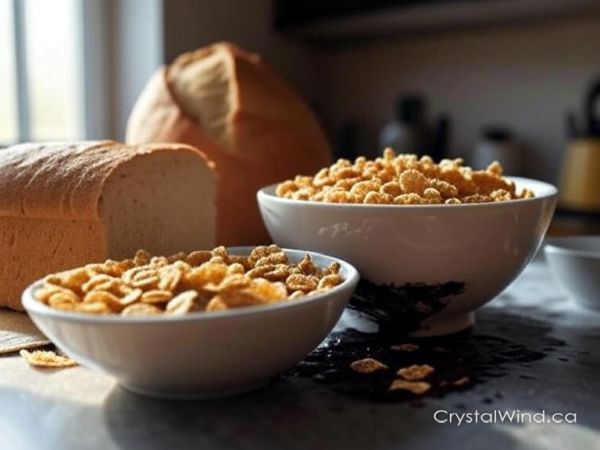Shocking: Forever Chemicals in Bread & Cereal Even Organic!
- Details
- Written by And-El
- Views: 11328

Imagine sitting down to a wholesome breakfast of organic cereal or a slice of freshly baked bread, confident in the purity of your meal. Now, picture the unsettling reality that even these seemingly safe choices could harbor toxic “forever chemicals.”
A recent study has sent shockwaves through the food industry, revealing that trifluoroacetic acid (TFA), a type of per- and polyfluoroalkyl substance (PFAS), has infiltrated breads, cereals, pastas, and flours—organic and conventional alike. This discovery, spearheaded by Global 2000, an Austrian environmental organization, underscores a pervasive contamination issue that challenges our assumptions about food safety. As these chemicals persist in the environment and our bodies, their presence in staple foods raises urgent questions about health risks and the steps we can take to protect ourselves.
The Alarming Findings of the Global 2000 Study
The Global 2000 report, conducted in collaboration with Pesticide Action Network (PAN) Europe, tested 48 cereal products in Austria, ranging from organic rye to conventional butter biscuits. The results were staggering: every single sample contained TFA, with levels ranging from 13 micrograms per kilogram (μg/kg) in organic rye to a staggering 420 μg/kg in conventional biscuits. Conventional products showed contamination levels over three times higher than their organic counterparts, yet even organic items exceeded 10 μg/kg—a threshold that raises concerns. Alarmingly, TFA levels in conventional products surpassed the Dutch health authorities’ daily tolerable intake for adults by up to 1.5 times and for young children by up to four times. These concentrations, which are two to three times higher than those found in drinking water, highlight the insidious reach of forever chemicals into our food supply. The study’s author, environmental chemist Helmut Burtscher-Schaden, emphasized that TFA, one of the smallest PFAS molecules, is not only present naturally but also forms as a breakdown product of PFAS-based pesticides, refrigerants, and pharmaceuticals like Prozac.
The persistence of TFA is what earns it the “forever chemical” moniker. Unlike other pollutants that degrade over time, PFAS compounds resist breakdown, accumulating in soil, water, and living organisms. The study revealed that plants absorb TFA from contaminated water and soil, concentrating it in grains and other crops. This bioaccumulation explains why even farms untouched by pesticides for decades still produce contaminated organic products. The chemicals’ mobility—traveling through air and water—means no farm is truly isolated from their reach. This widespread contamination, coupled with TFA’s ability to persist indefinitely, paints a grim picture of a food system under siege by an invisible threat.

Health Risks: A Growing Concern
The health implications of TFA and other PFAS are deeply troubling. Research links PFAS exposure to a host of serious conditions, including reproductive toxicity, developmental harm in children, and increased risks of cancers such as kidney and testicular cancer. The European Environment Agency has also associated PFAS with thyroid disease, liver damage, and fertility issues. TFA’s small size allows it to penetrate biological barriers easily, making it particularly concerning. Studies suggest it can impair fetal development and disrupt hormonal systems, posing significant risks to vulnerable populations like pregnant women and young children. Tjerk Dalhuisen from PAN Europe described the situation as “alarming,” noting that TFA’s toxicity to reproduction and its potential to harm child development necessitate immediate action to curb its sources.
What makes this issue even more pressing is the lack of regulatory oversight in some regions. In the United States, the Environmental Protection Agency (EPA) has not classified TFA as a PFAS nor established a daily allowable limit for its intake. This regulatory gap leaves consumers vulnerable, as the EPA’s stance contrasts with European efforts to set stricter guidelines. For instance, the European Commission recommends investigating PFAS contamination in food when levels exceed certain thresholds, a proactive approach absent in current U.S. policy. The absence of clear standards amplifies the urgency for consumers to educate themselves and advocate for change.
How Forever Chemicals Invade Our Food
Understanding the pathways of TFA contamination is key to grasping the scale of the problem. PFAS, including TFA, originate from multiple sources: pesticides, industrial chemicals, refrigerants, and even household products like non-stick cookware. When PFAS-based pesticides are sprayed on fields, they break down into TFA, which then seeps into soil and water. Plants, particularly water-intensive crops like wheat and rye, absorb these chemicals, concentrating them in the harvested grains. The Global 2000 study noted that plants transpire large amounts of water, leaving behind higher TFA concentrations in their biomass. This process explains why cereal products contain significantly more TFA than drinking water or groundwater.
Even organic farming, often seen as a bastion of purity, is not immune. Organic standards prohibit PFAS-based pesticides, but the chemicals’ environmental persistence means they linger in soil and water from past conventional farming practices or nearby contamination sources. Biosolids, or treated sewage sludge used as fertilizer on conventional farms, are a major culprit, carrying PFAS residues that can contaminate fields for decades. Additionally, PFAS can migrate through air and water, reaching organic farms hundreds of miles away. Manufacturing processes and packaging also introduce risks, as equipment or materials treated with PFAS can transfer these chemicals to food. This complex web of contamination underscores the challenge of achieving a truly PFAS-free food supply.

Strategies to Minimize Exposure
While the pervasiveness of TFA is daunting, consumers are not powerless. Making informed choices can reduce exposure, though no solution is foolproof. Opting for organic products remains a wise strategy, as the Global 2000 study found significantly lower TFA levels in organic items compared to conventional ones. However, consumers should prioritize products from long-established organic farms, as newer conversions may still carry residual contamination from prior conventional practices. Ancient grains like Kamut, Einkorn, and Spelt, often grown by small-scale organic producers, may offer a safer alternative to heavily processed wheat-based products, which showed the highest contamination levels.
Diversifying your diet is another effective approach. Relying less on wheat and corn-based products reduces the risk of concentrated TFA exposure. Incorporating more fresh fruits, vegetables, and legumes, particularly those high in fiber and folate, may help mitigate PFAS absorption in the body, according to some studies. Sourcing food from local, trusted farms that prioritize sustainable practices can further minimize risks, as these producers are less likely to rely on chemical-intensive methods. When shopping, become a label detective: avoid heavily processed cereals and baked goods with unpronounceable ingredients, as these often indicate industrial processing that may introduce additional contaminants.
Beyond personal choices, systemic change is critical. Advocating for stricter regulations on PFAS use in agriculture and manufacturing can drive meaningful progress. Supporting organizations like PAN Europe, which calls for banning PFAS-based pesticides, amplifies the push for a PFAS-free economy. Consumers can also pressure food companies to test for PFAS and transition to safer alternatives, as some retailers have already begun phasing out PFAS in packaging. Raising awareness about the issue empowers communities to demand accountability from policymakers and industry leaders.
The Path Forward: A Call to Action
The discovery of forever chemicals in breads and cereals, even organic ones, is a wake-up call. It reveals the deep-rooted challenges of a food system grappling with persistent pollutants and highlights the need for collective action. While individual efforts to choose safer foods are vital, the responsibility cannot rest solely on consumers. Governments must enforce robust regulations, and industries must innovate to eliminate PFAS from production chains. The Global 2000 study serves as a stark reminder that no food is immune to contamination in an environment saturated with forever chemicals, but it also sparks hope that awareness and action can pave the way for a healthier future.
As you reflect on this issue, consider the power of your voice and choices. Share this information with friends and family to spark conversations about food safety and environmental health. Comment below with your thoughts or strategies for navigating this challenge—your insights could inspire others. Together, we can push for a world where our daily bread is truly safe and nourishing.
Sources
- TFA in Cereal Products: The Forever Chemical in our Daily Bread, Global 2000 and Pesticide Action Network (PAN) Europe, June 2025.
- ‘Forever Chemical’ Found in Breads and Cereals — Even in Organic Products, Children’s Health Defense, June 23, 2025.
- The global threat from the irreversible accumulation of trifluoroacetic acid (TFA), Arp et al., Environmental Science & Technology, Volume 58, Issue 45, 2024, pp. 19925-19935.
- Ultrashort-chain perfluoroalkyl substance trifluoroacetate (TFA) in beer and tea–An unintended aqueous extraction, Scheurer and Nödler, Food Chemistry, Volume 351, 2021, Article 129304.
- RIVM-VSP Advies 14434A02 – Drinkwaterrichtwaarde Voor Trifluorazijnzuur, Dutch National Institute for Public Health and the Environment (RIVM), 2023.
- Trifluoressigsäure (TFA): Bewertung für Einstufung, German Environment Agency (UBA), Submission to European Chemicals Agency (ECHA), May 2025.
And-El, a mystic with over 30 years of spiritual and telecom expertise, founded CrystalWind.ca in 2008 as a global hub for seekers. His 58-card Crystal Wind Oracle Myth & Magic Deck guides transformation worldwide. Explore more at CrystalWind.ca. Connect with #LightWarrior, #SpiritualJourney, #Awakening, #CrystalHealing.
© 2025 And-El & CrystalWind.ca. All rights reserved. Licensed under CC BY-ND 4.0. Share freely with author’s name, this notice, and a link to https://www.crystalwind.ca. No changes allowed without written permission.
Liked this article? Dive deeper into personal growth and wellness! Check out CrystalWind.ca for spiritual wisdom or explore AromaWorx.ca for natural well-being tips. Spread the positivity—share this with friends on their happiness journey!
Let’s Chat! Drop Your Thoughts Below! ![]()
Disclaimer Health
All post and information provided within this blog is for educational and informational purposes only, and is not to be construed as medical advice or instruction. No action should be taken solely on the contents of this website. Please consult with your healthcare professional before making any dietary or lifestyle changes or taking supplements that may interfere with medications. Any products or information discussed are not intended to diagnose, prevent, treat or cure any illness, disease or lifestyle. Please consult your physician or a qualified health professional on any matters regarding your health and wellbeing or on any opinions expressed within this website.
Latest Articles

Imagine a world of inspiration and healing, free for all—made possible by YOU!
Donate Now—Ignite the Magic at CrystalWind.ca!

Epilepsy - Finding A Cure
Your donation can make a difference!
Help us find a cure – donate now!
Unlock Your Light: Join Lightworkers Worldwide on CrystalWind.ca!
Follow Us!
Featured This Month
Peridot: The Healer's Stone
Peridot has been used as a Power Stone for centuries. Peridot fosters emotio... Read more
The Vine: September 2nd - September 29th
The Autumnal Equinox ( Alban Elfed ) Celtic Symbol : The White Swan Read more
Mabon in Modern Times: Fresh Takes on the Au…
The Mabon season begins somewhere around the 21st-22nd of September and cont... Read more
Virgo Mythology
The Virgo Myth In all of constellation mythology, few legends are as misund... Read more
Sun in Virgo
An Overview of Sun Sign Characteristics for Virgo Virgo is guided by Mercur... Read more
Crystals for Virgo
As the warmth of summer begins to soften into the crispness of autumn, the Sun... Read more
Mabon Magic: Ideas For Fall Decoration And R…
Welcome (almost!) to Fall! We’re turning the Great Wheel once again, toward ... Read more
Watermelon Tourmaline
Synonym: Rainbow Tourmaline The watermelon tourmaline is a rare variety t... Read more
Sweet Violet
Sweet Violet Faithfulness and modesty. “I will always be true to you.” Helps... Read more































































































































































